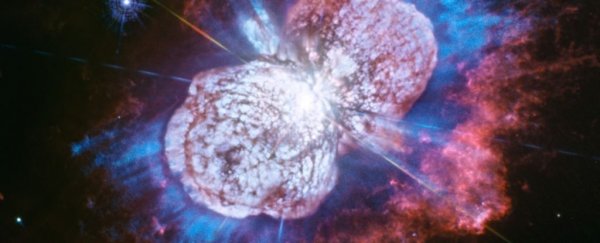A star that exploded into brightness nearly 200 years ago can now be explored in glorious, multi-wavelength detail. In a new video, a team of scientists modeled the Homunculus Nebula around the star Eta Carinae in three dimensions, enabling insight into this incredible event.
The binary system Eta Carinae started erupting in the late 1830s and became one of the brightest stars in the night sky for years by the early 1840s. The gas and dust this eruption ejected into the space around the binary is known as the Homunculus Nebula, the gradual expansion of which obscured the star so that it could no longer be seen at all with the naked eye.
The fascinating bi-lobed shape of the Homunculus Nebula can help us better understand the eruptions of massive binary stars and how such nebulae propagate through space. At just 7,500 light-years away, it's one of the closest examples of this type of system, so we've studied it a lot.
The new models are a continuation of these probes into the giant structure. Hubble and Chandra observations have revealed details in visible, ultraviolet, and X-ray radiation, while the Spitzer Space Telescope has contributed infrared wavelengths of the wider Carina Nebula for a holistic reconstruction.
"The team did such an amazing job representing the volumetric layers that viewers can immediately and intuitively comprehend the complex structure around Eta Car," said astronomer Frank Summers, principal visualization scientist at the Space Telescope Science Institute (STScI).
"We can not only tell the story of the Great Eruption, but also showcase the resulting nebula in 3D."
Because the region is so dusty, it's challenging to get a very detailed handle on the stars themselves. We know that there are at least two stars, both of them blue giants. One is around 100 times the mass of the Sun, the other between 30 and 80 times the mass of the Sun. They orbit each other once every 5.5 years.
Such stars are quite short-lived and will periodically erupt throughout their brief lives. But the Great Eruption of the 1840s was more akin to a supernova, which led astronomers to think that the system was originally a trinary, and perhaps the outburst was the result of two stars of the three colliding and merging. That would explain a few outstanding questions, including how one of the stars may be so much more massive than the other.
Currently, Eta Carinae is once again visible to the naked eye (depending on the level of light pollution). Astronomers believe that it could end its life in a massive supernova, which in turn could see the formation of a stellar-mass black hole.
Given that we don't know much about the stars themselves, though, the binary's future is difficult to predict. In addition, stars in close stellar binaries can destabilize each other and disrupt the normal course of events.
This means that not only can Eta Carinae help us understand massive stars, but it's also a window into the strangeness of massive close binaries. Researchers can also use the data to generate physical ways to explore the nebula. This is not just a learning tool; sometimes, making cosmic phenomena accessible to our other senses, such as hearing or touch, can lead to new insights.
"We can take these models like the one for Eta Car and use them in 3D printing and augmented reality programs," said visualization scientist Kim Arcand of the Chandra X-ray Center. "This means more people can put their hands on the data – literally and virtually – and this makes for better learning and engagement."
You can explore Eta Carinae in more detail on the Universe Unplugged website.
